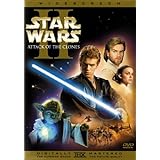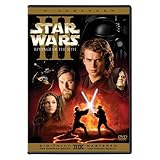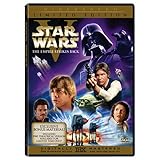- Harrison Ford to George Lucas on the set of Star Wars Episode IV: A New Hope, 1976
 |
| Click Poster to Purchase DVD on Amazon.com |
So how do you stop your characters from sounding as annoying as Jar-Jar Binks or as pedantic as C-3PO? How do prevent them from becoming roaring, one-note anger machines like Chewbacca or indecipherable fountains of pseudo-wisdom like Yoda? The best way to prevent your character's dialogue from grating on the ears of the audience is to examine the purposes that dialogue serves in your script.
 |
| Click Poster to Purchase DVD on Amazon.com |
Jump into Hyperspace: Move the Story Forward
Many new writers misinterpret the purpose of dialogue. They often use dialogue to tell the story, rather than use it to move the story forward. Audiences want to see what the characters want and what they'll do to get it, rather than hear them talk about it incessantly. While you may need some dialogue for exposition, especially if your story-world that does not directly correspond to the here-and-now, find ways to include how these facts and figures have a direct impact on the characters and their actions. |
| Click Poster to Purchase DVD on Amazon.com |
Master and Apprentice: Define Character Relationships
You can also use dialogue to establish the relationships between characters. Your main character will inevitably use different language, tones and approaches with the other characters in relation to their roles in his life. An effective script would have the main character speak differently to his secret wife than to his mentor and friend.Your dialogue should also change as the relationships between those characters change. The protagonist would speak with more deference to a mentor as his student, then turn more familiar as the relationship evolves, then become more confrontational as the student's ambition destroys the relationship.
 |
| Click Poster to Purchase DVD on Amazon.com |
Do or Do Not: Focus on Character VOTE
In a previous post, we discussed the VOTE approach. This approach summarizes each character's Victories, Obstacles, Tactics and Energy. Each of these factors also determines how the characters will speak to each other. Every line of your dialogue should answer these questions wherever possible:- What does that character want out of that conversation?
- Which subjects will they avoid?
- Which conversational tactics will they use to reach their objectives?
- How will they show the energy that drives them toward that desired outcome?
 |
| Click Poster to Purchase DVD on Amazon.com |
Lightsabers and Turbolasers: Define the Character's Speech Patterns
Just as a Harvard professor will often employ a more extensive vocabulary and more precise grammar than a third-grade dropout, you must define the level of vocabulary and speech patterns that fit your characters. A virtuous character may refrain from profanity when calm and sober, but turn the air blue with curse words when upset or intoxicated. An educated character may be erudite and witty with colleagues, but revert to immature and crass humor with childhood friends. |
| Click Poster to Purchase DVD on Amazon.com |
Feel the Force: Use Minimal Dialogue
The key factor to remember about dialogue is “Show, Don't Tell”. If you have the option to tell the story through action rather than through dialogue, take the action option. Unlike novels, which require the writer to spell out every facet of the story in detail, screenplays serve as a blueprint for the story. The story itself unfolds in front of the audience on the screen; the images, sounds and action carry the story, which reduces the need for long stretches of dialogue. |
| Click Box to Purchase Blu-Ray Set on Amazon.com |
If you want your dialogue to ignite a producer's interest like a lightsaber blade, contact us at StoryIntoScreenplayBlog [at] gmail [dot] com. We can help you create memorable characters with sharp dialogue, unique phrasing and unforgettable voices. You can also follow us on Facebook and Twitter for the latest updates.
Good luck, and may the Force be with you!

No comments:
Post a Comment